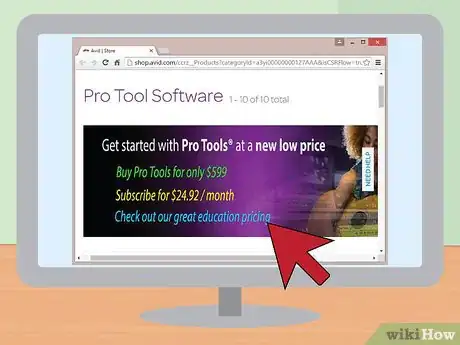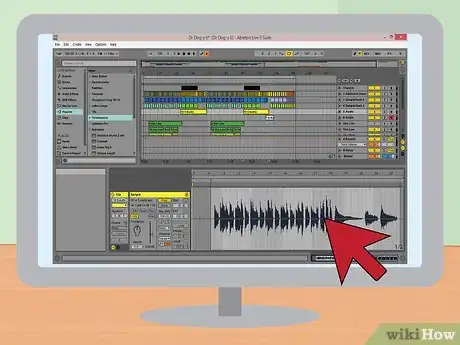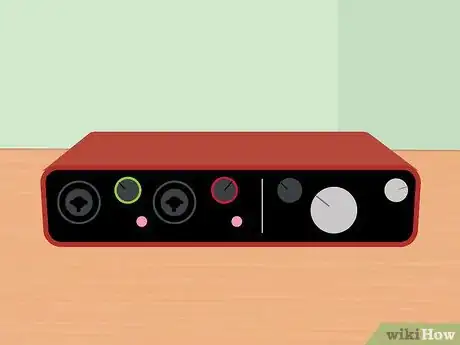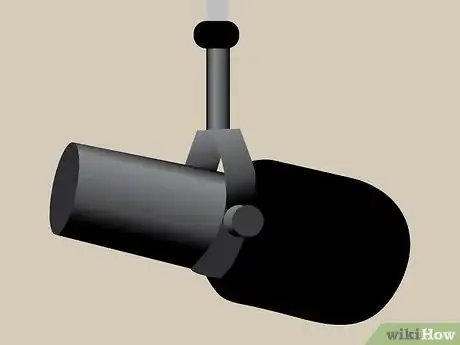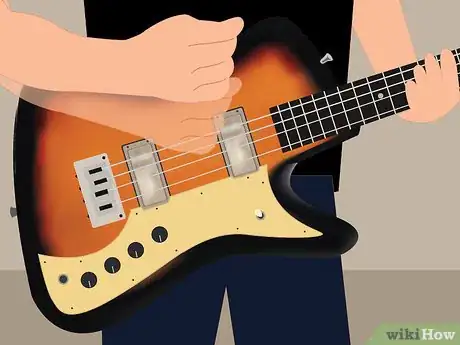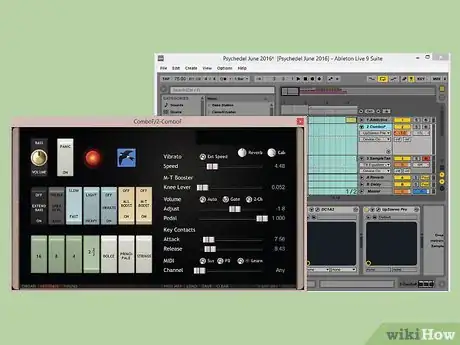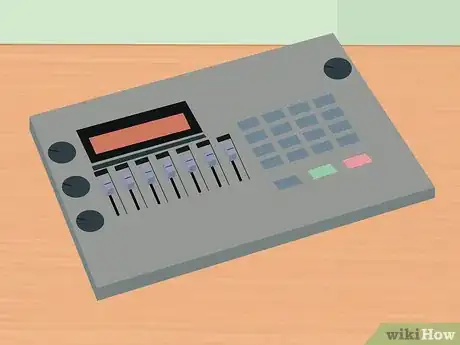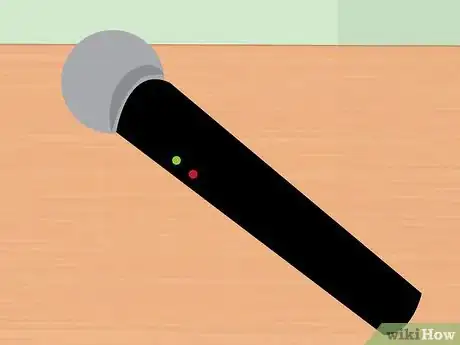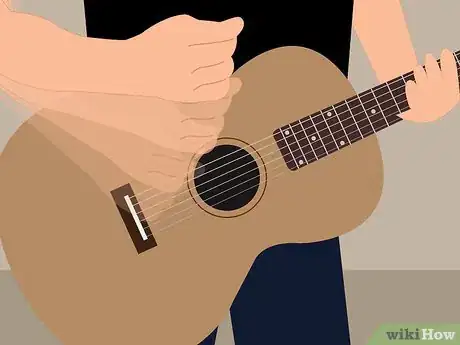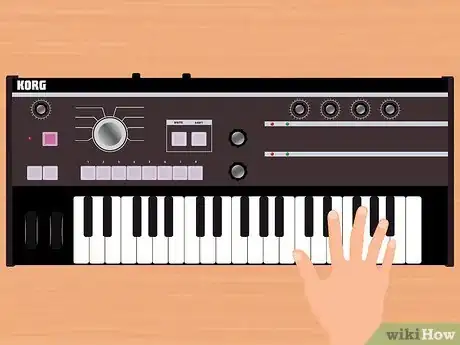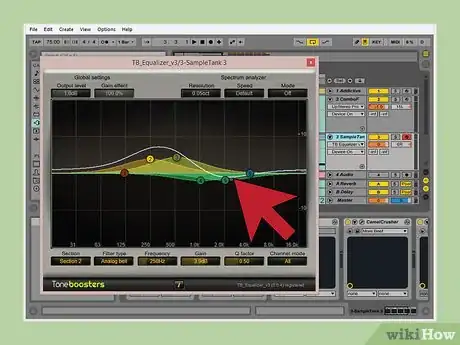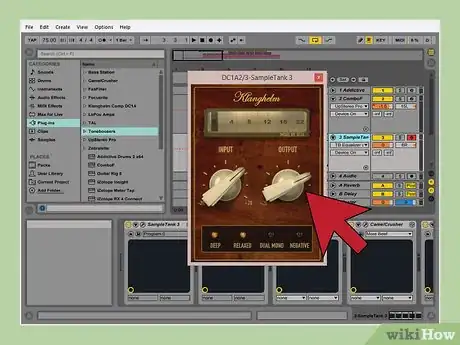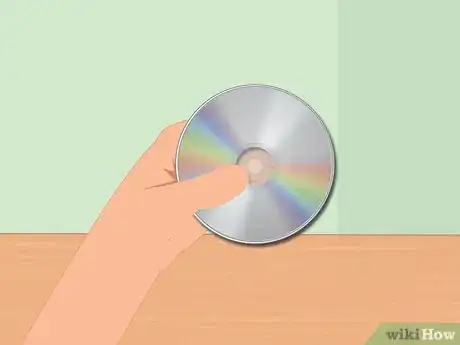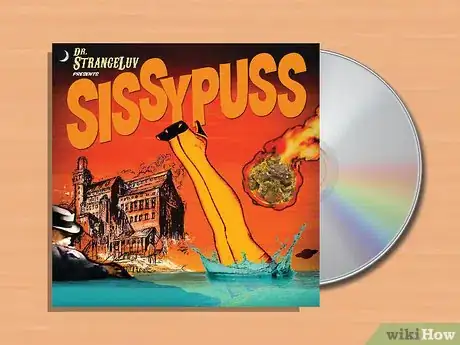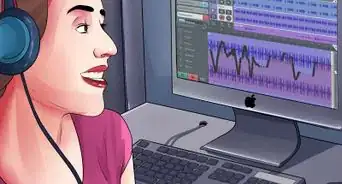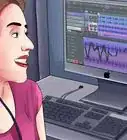This article was co-authored by Aaron Asghari. Aaron Asghari is a Professional Guitarist and the lead guitarist of The Ghost Next Door. He received his degree in Guitar Performance from the Guitar Institute of Technology program in Los Angeles. In addition to writing and performing with The Ghost Next Door, he is the founder and primary guitar instructor of Asghari Guitar Lessons.
This article has been viewed 258,183 times.
You don’t need a large studio and a team of audio technicians to make an album. There are several tools, many of which are affordable, that can convert your bedroom into a mini studio. Many recording artists enjoy writing music as they record but it will help you to have a number of song ideas and fully-formed songs written before beginning recording.
Steps
Recording an Album on Your Computer
-
1Download recording software. There are several options available for recording music. Macs, for instance, come with a full recording suite called Garageband. Go online and research different software and then decide which one is the best fit for you.
- Recording software usually offers a free trial period. Download a few of these to test your options.
- The industry standards are ProTools and Logic. You can also check out software like Ableton Live, Reason, Fruity Loops, and Audacity.[1]
- Completely free software like Reaper or Acid are also popular and have similar features to Protools and Logic.
EXPERT TIPAaron Asghari is a Professional Guitarist and the lead guitarist of The Ghost Next Door. He received his degree in Guitar Performance from the Guitar Institute of Technology program in Los Angeles. In addition to writing and performing with The Ghost Next Door, he is the founder and primary guitar instructor of Asghari Guitar Lessons.Professional Guitarist & Instructor
 Aaron Asghari
Aaron Asghari
Professional Guitarist & InstructorOur Expert Agrees: If you want to record an album without a studio, you'll at least need access to basic recording software and gear.
-
2Learn the basics of the software. Spend a couple weeks experimenting with the software. There are tons of tutorial videos available for free, and many are created by the software company directly.
- If you run into trouble and can’t figure something out, google it. State the software’s name and what you’re trying to do. It's often easy to find an answer this way.
Advertisement -
3Invest in an interface. An audio interface allows you to plug in an instrument like a guitar or a microphone, and record onto the computer without a delay in timing. Research an interface that will be the most compatible with your computer and recording needs. Interfaces can have one or multiple input jacks for simultaneous recording. Some larger modules may have up to 16 input jacks and a built in mixer.
- Interfaces range greatly in price, so consider your specific needs before committing.
- Most interfaces come with a combination of XLR (standard for microphones) and ¼” jacks (standard for guitars and keyboards).
- Several interfaces also come with recording software or an extended trial of software. Check out all the features of the prospective interface before purchasing it.
-
4Consider getting a microphone. Be realistic on what you are trying to achieve. Microphones are incredibly useful for a home studio. Even if you plan on making instrumental or electronic music, you can still utilize a microphone for recording. Picking out a microphone is a complex process that varies based on what you want to record.
- The most versatile microphone you can record anything with is a condenser microphone. The rule with microphones is that if you want a quality mic, you’ll need to pay at least $100, if not more.
- If you want to skip using an interface, invest in an USB microphone. USB microphones plug directly into your computer and are designed not to delay or lag in real time.[2]
-
5Record your first song. The best way to start recording a song is to first record an idea in your head. An example of an idea is a drum beat or a funky bass line you keep thinking about. These are launching points for songs. Once you record the foundation of your idea, you’ll be inspired to add different layers to your track.
- It’s best to record along to a metronome. You can even setup a click track by using a software drum loop to play along with while recording.
-
6Add layers to your song. Continue to experiment with the song until you feel it is complete. The beauty of digital recording is that you are able to add an unlimited number of tracks. Note however that good songwriting and production is often about restraint.
- If you have multiple collaborators, choose to have one person play their part with the recording. There is no order that the members should play in, but let them play until they have perfected their part.
- You might want to record a phrase of a track at a time, rather than record the whole track in one sitting.
-
7Edit the tracks. The best part about recording on your computer is that you can easily edit the material. If you are recording a vocal line and aren’t happy with the chorus, you can splice out the chorus, record the chorus on a new track, and edit the newly recorded chorus to fit in seamlessly.
- Whenever you run into a wall with understanding how to do something, research your problem with a search engine.
- Editing a song is similar to editing a video, it can make or break the track. Be sure to edit the introduction down to where you want it, and do the same for the ending.
- Decide how you want the volume to work in the track. You can edit the song so that it fades in, or adjust the volume so it fades out.
Using a Multi Track Recorder
-
1Pick out a decent recorder. The home recording staple is the four-track (sometimes called digital multitrack recorders). You can still buy an analog four track that records onto a regular cassette tape, but these are harder to find in working condition. You can also invest in a higher quality reel to reel tape recorder.
- One of the most popular brands for home recording multitrack systems is Tascam.[3]
- Four track recorders are machines designed to record four tracks on either a memory card or tape. With the four track, you can record four live takes at once, or layer up to four tracks on top of one another.
- You can alternatively purchase an eight track recorder for more multitrack recording possibilities.
-
2Purchase a microphone. You will need a microphone for a multitrack recorder. The best type of microphone to get for a variety of purposes is a condenser microphone. You can alternatively get a couple of high or low quality dynamic microphones. Choosing a microphone is a complex process that depends on your recording goals and budget.
- Multiple microphones will be better to record multiple tracks with your recorder. You can add more parts with more musicians by using multiple microphones.
-
3Experiment with the recorder. Read the manual or start experimenting with your recorder. Think of how the effects on the recorder can be used in your songs and remember any notable qualities of the recorder. Several multitrack recorder have the capability to bounce tracks. Bouncing tracks combines two or more recorded tracks into one track.
- Make a few silly demos while you are starting to understand how to use the device. You never know what you may like and what to add to the album.
- Bouncing tracks reduces the sound quality, so be wary bouncing too many tracks.
-
4Record your first track. The best way to start recording a song is to first record an idea in your head. An example of an idea is a drum beat or a funky bass line you keep thinking about. These are launching points for songs. Once you record the foundation of your idea, you’ll be inspired to add different layers to your track.
- Choose a song to begin with and have the whole band record at the same time. It does not matter if it sounds bad as long as there is a steady beat and a feel for the song.[4]
-
5Add layers to your song. If you are using a tape recorder, you need to plan out the design of the song in advance. Digital recording is much more forgiving than analog recording. The best way to utilize a tape recorder is with multiple microphones and a mixer. With a mixer you can perform a live set and mix it into one track. Then you can use the remaining tracks for overdubs.
- For example, set up multiple microphones to record the guitar, bass, and drums. Send those mics through the mixer and into one track of your four track. Then you can spend three additional tracks on vocals, lead guitar, and any other layers you want to add.
Finalizing the Album
-
1Mix the song. Mixing is the process of affecting parts of a single track and the overall master track. You can edit the high, low, and mid frequency range for each track. Once the tracks sound good together, experiment with panning the tracks to the left or right. Panning is a good way to isolate a track and blend it in with other tracks.
- Most multitrack recorders come equipped with an equalizer (EQ).
- Mixing can help accent parts you want to be more present, or even hide parts you're not thrilled about.
- Equalize each track and balance everyone. Low sounds should be the strongest for a good balance.
- For inspiration listen to the Beatles with headphones. They only had a four track recorder and you can hear multiple complex parts interacting and balancing each other out.
-
2Add production effects. Once you record your album, you can add certain effects that will improve the sound of the album. Popular post-production effects are compression and reverb. Compression squeezes the track together, lessening the dynamic range between the loud and quiet parts of the song.[5]
- As compression brings elements of the sound together, reverb redistributes the sound to fill a space. Reverb widens the sound wave by stimulating the sound bouncing off multiple surfaces.
-
3Master the album. Mastering is a compression technique used in post-production to ensure every song is equal in volume. You also strive to achieve an equal balance in each speaker. Mastering is not an easy process and may require a more experienced engineer.
- Some music software programs come equipped with a simple form of mastering.
- Record labels will typically have their own engineer to master an album they plan on releasing.
- There are different techniques for mastering, depending on the form you release your album (vinyl, CD, cassette, or stream).
-
4Make a demo of the album. Burn the CD through the recorder or computer and give it a listen. If it does not sound good in a stereo system or headphones, decide if you want to record certain songs again.
- Pass a few copies of the demo out to trusted friends and fellow musicians. Ask them for constructive feedback on the album to determine if the songs are working.[6]
-
5Design a cover. Create album art and make the album look good. You can create an image using a design software like Photoshop or Illustrator. Another option you could do is to use a photo of something.
- Look at your favorite album covers to decide if you want to pay an artist to do something special like Santana's album Abraxas.
- Then there are famous album covers that are nothing but a picture like The Beatles' Abbey Road.
Community Q&A
-
QuestionIs it possible to record a song with only a laptop and a phone?
 Community AnswerYes. Some software allows you to record only with the help of a laptop. There are even specific microphones and other effect and synthesizer bundles you could buy for various applications.
Community AnswerYes. Some software allows you to record only with the help of a laptop. There are even specific microphones and other effect and synthesizer bundles you could buy for various applications. -
QuestionIs it okay to use an earphone?
 Community AnswerYes, you may use an earphone during the recording process.
Community AnswerYes, you may use an earphone during the recording process. -
QuestionHow can I get my album on Spotify?
 Community AnswerThere are several companies who can match artists up with Spotify to stream their music. A list of these companies can be found on Spotify's website. If you have signed with a label, they can usually get your music on Spotify for you.
Community AnswerThere are several companies who can match artists up with Spotify to stream their music. A list of these companies can be found on Spotify's website. If you have signed with a label, they can usually get your music on Spotify for you.
Warnings
- Do not rush the process. It is long, but worth it if every song is meticulously made.⧼thumbs_response⧽
References
- ↑ http://www.jerseybeat.com/homerec.html
- ↑ http://diymusician.cdbaby.com/musician-tips/5-essential-components-home-recording-studio/
- ↑ http://homerecording.com/4trackfaq.html
- ↑ https://sourceforge.net/projects/audacity/
- ↑ http://music.tutsplus.com/tutorials/the-beginners-guide-to-compression--audio-953
- ↑ http://www.theguardian.com/careers/music-producer-career-advice
